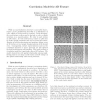Free Online Productivity Tools
i2Speak
i2Symbol
i2OCR
iTex2Img
iWeb2Print
iWeb2Shot
i2Type
iPdf2Split
iPdf2Merge
i2Bopomofo
i2Arabic
i2Style
i2Image
i2PDF
iLatex2Rtf
Sci2ools
118
click to vote
ICCV
1999
IEEE
1999
IEEE
Correlation Model for 3D Texture
While an exact definition of texture is somewhat elusive, texture can be qualitatively described as a distribution of color, albedo or local normal on a surface. In the literature, the word texture is often used to describe a color or albedo variation on a smooth surface. We refer to such texture as 2D texture. In real world scenes, texture is often due to surface height variations and can be termed 3D texture. Because of local foreshortening and masking, oblique views of 3D texture are not simple transformations of the frontal view. Consequently, texture representations such as the correlation function or power spectrum are also affected by local foreshortening and masking. This work presents a correlation model for a particular class of 3D textures. The model characterizes the spatial relationship among neighboring pixels in an image of 3D texture and the change of this spatial relationship with viewing direction.
Computer Vision | Correlation Model | ICCV 1999 | Local Foreshortening | Spatial Relationship | Texture Representations | Word Texture |
Related Content
| Added | 15 Oct 2009 |
| Updated | 15 Oct 2009 |
| Type | Conference |
| Year | 1999 |
| Where | ICCV |
| Authors | Kristin J. Dana, Shree K. Nayar |
Comments (0)

